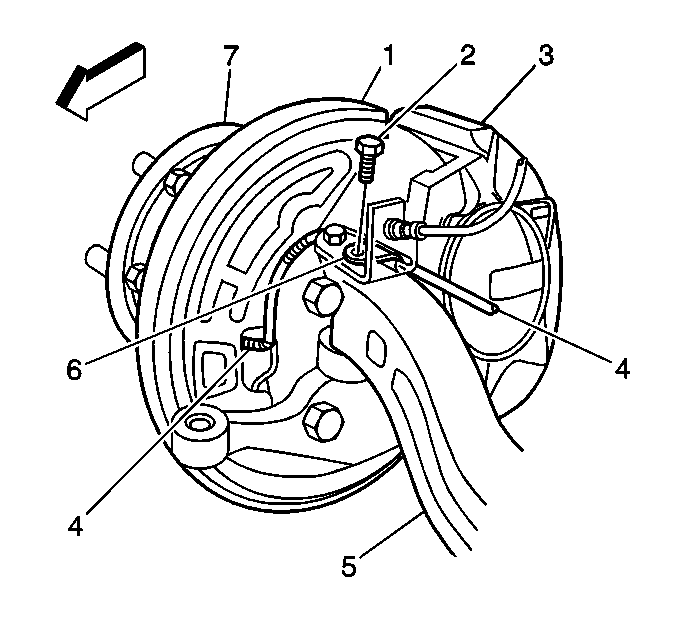Use the brake caliper mounting plate in order to mount all of the stationary brake components. An L or R following the part number cast on the back of the plates indicates left or right side mounting. Some plates may also have an L or R painted on the front.
Removal Procedure
- Remove the brake caliper (3) from the mounting bracket and support the caliper with heavy mechanic's wire or equivalent. DO NOT disconnect the hydraulic brake flexible hose from the caliper. Refer to Front Brake Caliper Replacement .
- Remove the hub and brake rotor (7) assembly. Refer to Front Wheel Hub, Bearing, and Seal Replacement .
- Remove the spindle to mounting plate nuts.
- Remove the spindle/mounting plate cover.
- Remove the brake caliper mounting plate.
- Inspect the support rails for rust, corrosion, and wear.
- Clean the support rails with a wire brush.
- Inspect the brake caliper mounting plate for cracks or elongated bolt holes.

Notice: Support the brake caliper with heavy mechanic wire, or equivalent, whenever it is separated from its mount and the hydraulic flexible brake hose is still connected. Failure to support the caliper in this manner will cause the flexible brake hose to bear the weight of the caliper, which may cause damage to the brake hose and in turn may cause a brake fluid leak.
Replace the mounting plate if necessary.
Installation Procedure
- Install the brake caliper mounting plate to the steering knuckle.
- Install the spindle/mounting plate cover.
- Apply 272® threadlocker to the threads of each brake caliper mounting plate bolt.
- Install the spindle to mounting plate nuts.
- Install the splash shield (1).
- Install the splash shield bolts.
- Install the hub and brake rotor (7) assembly. Refer to Front Wheel Hub, Bearing, and Seal Replacement .
- Install the brake caliper (3). Refer to Front Brake Caliper Replacement .
- Install the tire and the wheel assembly. Refer to Tire and Wheel Removal and Installation in Tires and Wheels.
- Lower the vehicle.
- With the engine OFF, gradually apply the brake pedal approximately 2/3 of it's travel distance.
- Slowly release the brake pedal.
- Wait 15 seconds, then repeat steps 11-12 until a firm brake pedal is obtained. This will properly seat the brake caliper pistons and brake pads.

Important: Ensure that the threads of each brake caliper mounting plate bolt are clean and greaseless before applying threadlocker.
Notice: Use the correct fastener in the correct location. Replacement fasteners must be the correct part number for that application. Fasteners requiring replacement or fasteners requiring the use of thread locking compound or sealant are identified in the service procedure. Do not use paints, lubricants, or corrosion inhibitors on fasteners or fastener joint surfaces unless specified. These coatings affect fastener torque and joint clamping force and may damage the fastener. Use the correct tightening sequence and specifications when installing fasteners in order to avoid damage to parts and systems.
Tighten
Tighten the brake caliper mounting plate nuts to 105 N·m
(78 lb ft).
Tighten
Tighten the splash shield bolts to 26 N·m (19 lb ft).
